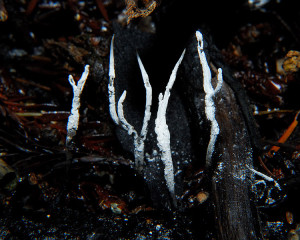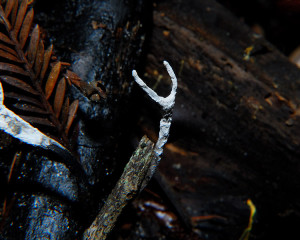Xylaria hypoxylon is a small club-like fungus found scattered or gregariously clustered on rotting wood. Commonly known as the Candle-snuff or Stag’s Horn fungus, Xylaria hypoxylon is found throughout North America and Europe, and may be encountered year round in California, although its small size makes this particular fungus very easy to overlook.
Xylaria Hypoxylon can appear slightly different depending on what stage the observer finds it. It may range in color from white to black, the white form being more readily discernible against the dark forest floor. This difference in color is because this species of fungus engages in both sexual and asexual reproduction. The primary fruiting bodies are black at the base, thin, wiry and branched with white tips. The white powdery tips are masses of asexual spores called conidia. The spores are produced inside microscopic tubules called asci. These asci are then bundled into perithecia, small nodules, which appear as black spots eventually turning the fungus black.
Xylaria hypoxylon grows 2-8 cm high and 3-5 mm wide, and may be scattered or clustered on rotting wood, and especially favors oak and tan-oak in the fall and winter in northern California. Its growth habit is erect, cylindrical or narrowly club-like when young, but as the fungus matures it usually becomes sparsely branched or forked at the tip, although occasionally lacks branches.
Candle-snuff fungus is not specifically toxic, but its tough texture renders this species inedible.
This is expected to be the last of our Mushroom Monday posts for a while, to make room for more updates on the orchard and gardens that are coming alive with the warmer weather, and now screaming for our undivided attention! It’s been a lot of fun discovering the numerous species of fungi lurking here this winter, and it was an exceptional year as a result of all our rain. Next fall, when the rains return in earnest, we will revive our ‘Mushroom Monday’ posts again. In the meantime, back to the gardens!












Dear CV, This is most interesting. I can well see why this particular fungus has the common name of Stag’s Horn, most apparent as you say in the white form.
I shall look forward to the autumn when you return to the subject again.
Every time you blog about fungi, it strikes me that although ‘our’ native plants are your invasives and vice versa, we do share the same fungi!
You last photo is especially beautiful and ghostly! Stunning! Fascinating creatures!
Amazing. I agree with Carol that the last photo is somehow ghostly. I might say beautiful, ephemeral and mysterious, though. 🙂 I think I may have seen these before on rotting wood — and never thought twice about them.
I have so enjoyed this series… but looking forward to orchard and garden updates, too!
Your posts nearly always bring me back to my plant biology days in college. They were then and still are just fascinating to me.
Goodbye mushroom mondays…. I enjoyed you!
I second Jess’s remark. This sounds wierd, but I saw jelly fungus the other day and thought of you! (That’s a good thing! I think.)
I’ve so enjoyed this series, because I’m not strong in mycology (I can identify maybe half a dozen species by name, most of those poisonous) and it’s fascinating to learn more about these vital, yet often ignored, organisms that share the earth with us. I always suspected that slime moulds would take over the universe, however.
A fascinating post. Fungi are a mystery to me – probably to most gardeners too. They do have a strange beauty though – as your pictures illustrate.
I need to know more about fungi, especilly about the kind, growing wild, that you can eat.
When I first read “Stags Horn”, I thought for certain it was my “stinkhorn” shroom…I paniced since I recently had a mishap with Evergreen Tree (our similar Tuity Fruity posts). OK…deep breath of relief! Your fungus series has been very interesting, indeed, and this one is no disappointment.